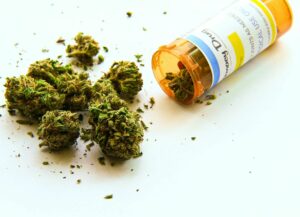Can using cannabis raise your risk of cancer? Many anti-drug campaigns and mainstream medical experts say that it can, adding that warning to the long list of reasons why cannabis is a dangerous drug capable of destroying lives. But marijuana consumers and advocates say that those claims are either overblown or downright false. Who’s right?
The cannabis plant contains more than 400 individual compounds. Most of these haven’t been separately studied, but so far none have been shown to be intrinsically carcinogenic. However, the best-known cannabis compounds, tetrahydrocannabinol (THC) and cannabidiol (CBD), appear to have both anti-carcinogenic and tumor-promoting properties.
FOLLOW US ON FACEBOOK & INSTAGRAM
Numerous studies on the health benefits of cannabis reveal that CBD can have an inhibiting effect on cancer cells, particularly in the lungs, breast, prostate and brain, while high doses of THC can trigger cancerous cell changes in some tissues. But the controversy over whether cannabis can cause cancer really relates not to the plant in its natural state, but to the ways people consume it: by smoking, eating or inhaling its vapors.
Is Smoking Marijuana Riskier Than Smoking Tobacco?
Though edibles and other ways of using cannabis are grabbing ever bigger shares of the growing medical cannabis market, many people still consume it the old-fashioned way: by smoking. For that reason, much of the research and discussion around the issue of cannabis and cancer risk are concerned with smoking the plant, and how that compares to smoking cigarettes containing nicotine and tar. Recent research suggests that aside from the fact that both can be lit, burned and inhaled, marijuana and tobacco really aren’t equivalent.
When materials of any kind are burned, combustion causes the release of toxins that can be inhaled along with the smoke. Some of these, such as benzene, are carcinogens that can damage various organs, especially the lungs. That’s true for both tobacco cigarettes and for cannabis joints, so simply smoking cannabis can expose someone to the carcinogens that come with combustion, just like smoking cigarettes would do. The question is: How much is that exposure?
Can We Trust the Studies?
A few years ago, the British Lung Foundation claimed that smoking marijuana is up to 20 times more likely to cause lung cancer than tobacco. The DEA, in a piece warning of the harmful effects of marijuana, also reported that when burned, cannabis releases up to 70% more carcinogenic gases than tobacco, and that the risk of exposure to these toxins is greater when smoking marijuana because smokers typically inhale more deeply and hold the smoke in their lungs longer.
But a number of studies, including one recently published in the Harm Reduction Journal,
point out that statistics like these are misleading at best. Cannabis and nicotine behave differently in the body, so the cancer risk from exposure to equivalent levels of carcinogens rises in the presence of nicotine, but falls in the presence of cannabinoids.
How Our Bodies React to Nicotine & Cannabis
The human body has many natural receptors for nicotine. These receptors can have some protective functions such as preventing damage to brain cells from beta amyloid plaque that causes Alzheimer’s disease. But many nicotine receptors exist in the epithelial cells that line the respiratory system, and that makes these cells especially vulnerable to damage from toxins created by burning tobacco.
The body also has an extensive network of naturally occurring cannabinoid receptors, which are found in many organs and tissues—but not in the respiratory epithelial cells. This, researchers say, probably explains why tobacco smoke can be demonstrably linked to cancers, but not cannabis. What’s more, cannabinoids can support processes that lead to the death of cancer cells.
So yes, there’s an overall risk that comes from inhaling hot gases and particulates, but smoking cannabis may present less of a cancer risk than smoking tobacco, while getting the many health benefits of cannabinoids.
RELATED: IS MARIJUANA RIGHT FOR YOU?
Is Vaping Safer Than Smoking Marijuana?
Vaping has been hailed as a safer way to “smoke” without the toxins that come from burning cannabis, and in general it can be—but that depends on the method of delivery. Some cannabis oils contain ingredients that also can release toxins and irritate the respiratory system when inhaled, and vaping at very high temperatures can also cause the release of harmful toxins.
What About Edibles?
The legalization of marijuana in many U.S. states and around the world has opened the door to new ways of consuming cannabis that don’t involve smoking, from artful edibles blended with chocolate and raspberry to candy bars, sodas and teas. But the cannabis plant itself contains no documented carcinogens, so the risk of cancer from eating cannabis is negligible, although other ingredients added to edibles could carry their own cancer risks.
Dabbing: Unsafe at High Temperatures
Another new way to consume cannabis is dabbing—heating highly concentrated pieces or dabs of extracted cannabis oil on a “nail,” a metal or glass compartment capable of reaching very high temperatures, and inhaling the vapors. Of all the ways people consume cannabis, dabbing can pose the highest risk of exposure to carcinogens if not done with caution.
The form of cannabis typically used in dabbing is butane hash oil, or BHO, a potent cannabis concentrate created by extracting cannabis oil using the highly flammable (and toxic) N-Butane. When placed on the nail of a dab rig and heated, the oil releases a potent vapor high in THC. Temperatures on a nail can exceed 900 F—and it’s that intense heat that exposes consumers
to high concentrations of chemicals that include the known carcinogens benzene and methacrylein.
Heating dabs at lower temperatures (at or below 700F, say consumers) lowers risk considerably, but many dabbing rigs don’t have the temperature controls that make it possible to monitor heating levels.
Cannabis is a plant rich in compounds with the potential to affect processes in the human body, including the development of cancer, and scientists are still working to understand how those compounds limit or promote the growth of cancer cells. For now, the known risks of cancer from cannabis relate more to how it’s consumed than to the plant itself—and consumers can take steps to reduce those risks.
Photo credit: Itay Kabalo
If you’re new to cannabis and want to learn more, take a look at our Cannabis 101 post. HelloMD can help you get your medical marijuana recommendation; it’s easy, private and 100% online.






